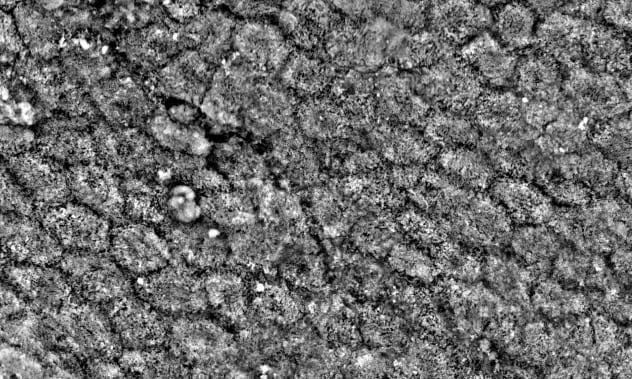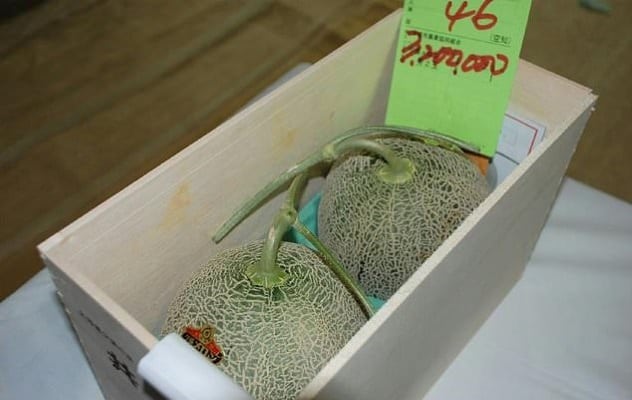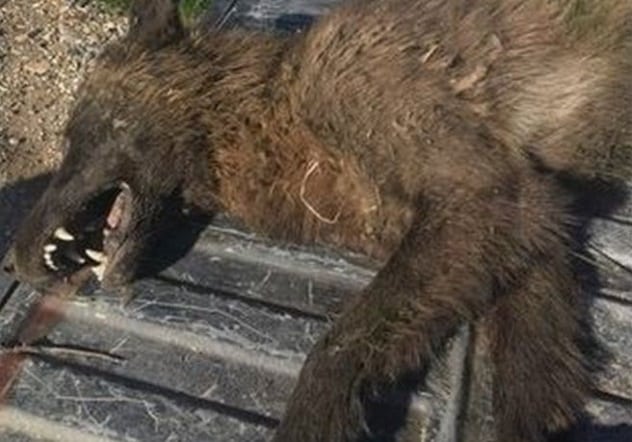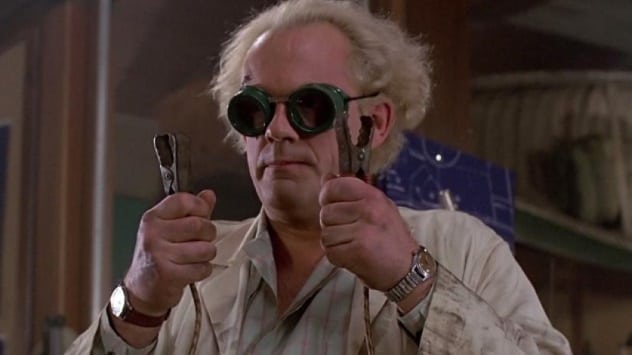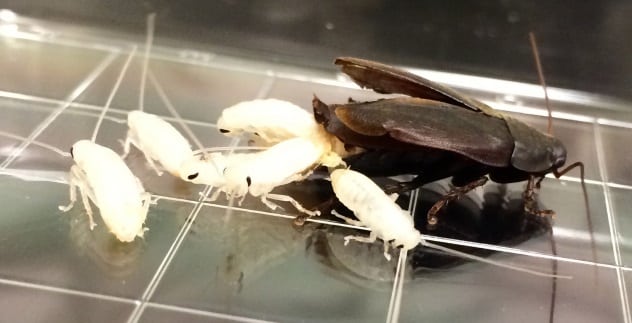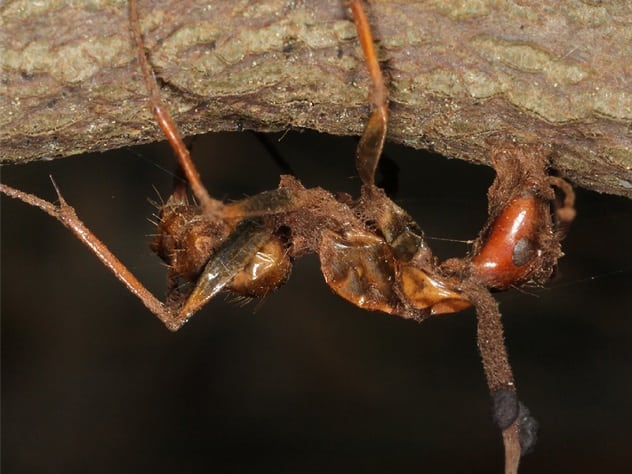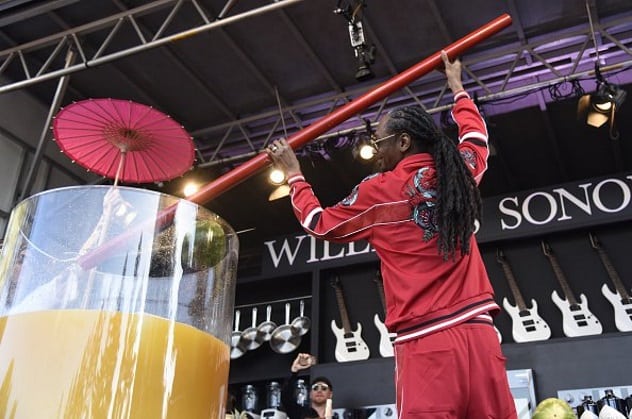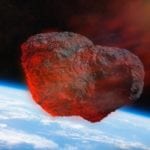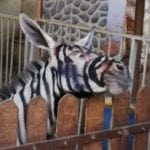It’s oddly specific, but this was a big week for food-based records. We got the priciest melons, the most cheese-rolling wins, and the largest gin and juice. It was also a pretty good time for science, as we explore some new and peculiar developments in paleontology, physics, cosmology, robotics, and evolutionary biology.
10 Oldest Dandruff In The World Found On Dinosaurs
They might have gone extinct tens of millions of years ago, but our knowledge of dinosaurs keeps on expanding. A new study published in Nature Communications talks about the first signs of how these prehistoric reptiles shed their skin. The evidence comes courtesy of the oldest-known dandruff in the world, found on a 125-million-year-old microraptor.[1] Paleontologists discovered well-preserved flakes of fossilized skin, which are almost identical to dandruff found on modern birds. Subsequent tests uncovered more bits of skin flakes on two other feathered dinosaurs, namely beipiaosaurus and sinornithosaurus, as well as an early crow-sized bird called confuciusornis. All the fossils were recovered from Northeastern China. The study suggests that dinosaurs evolved dandruff to help them cope with another new innovation—feathers. The argument is strengthened by the fact that feathered dinosaurs shed their skin in tiny bits, similar to modern birds, as opposed to modern reptiles, which cast off their outer layer all at once. There does seem to be one key difference between dino and bird dandruff. The prehistoric skin cells were composed of corneocytes filled with keratin. Modern birds have very fatty dandruff cells, which helps them shed heat while flying. Study lead author Dr. Maria McNamara speculates that feathered dinosaurs had a lower body temperature than birds, perhaps even a “transitional metabolism between a cold blooded reptile and a warm blooded bird.”
9 Pair Of Melons Sold For $29,000
An auction in Hokkaido set a new record when it sold two Yubari melons for 3.2 million yen ($29,300). The winning bidder was Shinya Noda, president of Hokuyu Pack, a fruit and vegetable packaging business. Right off the bat, he was determined to make a record-setting bid in order to celebrate his company’s 30th anniversary.[2] He plans to keep the lavish purchase on display until the end of the month. Afterward, the melons will be cut into small pieces, which will be given to customers as gifts. The melons in question are actually hybrid cantaloupe cultivars made only in the small city of Yubari. They’re always expensive, although typically no more than $100. The ones that command high prices at auctions have something special: They are the first Yubari melons sold during that harvest season. Even though there were over 500 of these cantaloupes sold at this year’s auction, only the first pair sold for a record-setting price. They are valued as a status symbol more than anything else, meant to show off your success as well as the flourishing Japanese economy. The previous record was set in 2016, also at a Japanese auction, where another pair of these extravagant melons fetched a price of three million yen.
8 The Mysterious Wolf-Dog Of Montana
Montana wildlife experts are currently baffled by a strange, wolf-like creature that a farmer killed on his ranch. In a press release, the Montana Department of Fish, Wildlife and Parks (MFWP) identified the slain animal only as a “young, non-lactating female” and as a canid, a member of the dog family. Tissue samples were collected and sent to the US Fish and Wildlife Service to extract DNA and compare markers against known species to obtain an identification. The farmer shot the animal on May 16, when it was approaching his livestock. MFWP released the images a few days ago. At first glance, the creature looks like a wolf, although experts have pointed out that a few features are off.[3] The coat looks different. The ears are too big, and the legs and paws are too small. The canine teeth are too short, while the claws are too long. Since the images made their way online, people have let their imaginations run wild as to the origins of the mysterious creature. Some believed it was some kind of mythological animal like a werewolf or a chupacabra, while others opined that it was a dire wolf that survived extinction. More sensible notions included a new breed of wolf or a dog/coyote/wolf hybrid.
7 Scientists Design Real Flux Capacitor
Fans of the Back to the Future franchise will know that the core component of Doc Brown’s time machine was a device called a flux capacitor. Now, physicists have proposed building a real one. However, it is unlikely that people will be traveling back in time to date their own mothers anytime soon, as this flux capacitor, unfortunately, has nothing to do with time travel. It is, in fact, a new-generation electronic circulator which can be used to control the direction of microwave signals. The idea is the brainchild of a team of Australian and Swiss scientists who published their proposed designs in Physical Review Letters. Their device would be built from a superconductor and contain one of two possible circuits. One of those two circuits features a three-pointed-star design similar to the iconic flux capacitor from the movie. Professor Jared Cole from RMIT University in Melbourne described it as “quantum ‘tubes’ of magnetic flux [that] move around a central capacitor by a process known as quantum tunneling, where they overcome classically insurmountable obstacles.”[4] The device should create an effect called broken time-reversal symmetry, which, despite the name, still has nothing to do with time travel. It actually means that signals would only move in one direction around a circuit. In the near future, this equipment could be used to improve Wi-Fi and radar. However, its true purpose could be as a key component for quantum computers.
6 Cockroach Milk Is The New Superfood
A lot of fitness fads can seem extreme or revolting, yet they always find people willing to try them out for a chance at a healthier or slimmer body. This latest trend is definitely one that will immediately put most people off. A research team in India believes that cockroach milk could become the latest superfood. The study was conducted by the Institute for Stem Cell Biology and Regenerative Medicine in Bangalore. It is actually two years old but is only now starting to pick up steam. The paper asserts that the cockroach produces a milk-like substance which is actually made up of protein-rich crystals that contain three times the energy of the equivalent mass of dairy milk.[5] The liquid is produced only by Diploptera punctata, better known as the Pacific beetle cockroach or the beetle mimic cockroach. It has the distinction of being among the few viviparous species of cockroach, meaning that it gives birth to live young instead of laying eggs. Even though they are hailing the benefits of cockroach milk, researchers are not advocating its consumption . . . yet. It is still unclear if the substance is safe for humans to drink. Then there are also practical obstacles to consider, like obtaining the liquid on a large scale or just getting people to drink something called “cockroach milk.”
5 Flippy The Robot Is Back To Making Burgers
After an inauspicious start, Flippy the hamburger-flipping robot has returned to work at the CaliBurger Restaurant in Pasadena, California. Built by Miso Robotics, Flippy was seen as a viable replacement for human short-order cooks. Too often, they quit their jobs after just a few weeks because they can’t stand the heat, thus requiring extra money to find and train replacements. This, alongside the added bonuses of consistency and no breaks, seemed to warrant Flippy’s $100,000 price tag. The robot debuted back in March to much fanfare and media attention. It lasted just one day before being decommissioned due to faults from both man and machine. While Flippy lived up to the promise of being able to cook 200 burgers an hour, it had trouble placing the finished patties on trays and would sometimes miss its target. Meanwhile, its human coworkers, who prepared the patties and assembled the burgers, hadn’t been trained to work alongside Flippy and were struggling to keep up.[6] The burger-flipping robot was shelved for a few months to work out the bugs and has now returned. So far, things are going much smoother, and CaliBurger has announced plans to add 50 more Flippys to its chain by 2019.
4 How Climate Change Affects Zombie Ants
A study recently published in the journal Evolution looks at how ancient climate change affected the behavior of a parasitic fungus called Ophiocordyceps. This fungus is known for producing the spores that create the infamous zombie ants. Infected insects are overwhelmed by an impulse to climb trees and bite down on leaves. Afterward, they die, and the fungi sprout from their heads, in perfect position to release their spores onto the forest floor and find new victims. This is what happens in South America. However, according to the paper, the same fungi behave differently in Japan, where leaves wither and fall off. Zombie ants climb higher up trees and grab onto twigs instead of leaves, even wrapping their limbs around them for extra grip.[7] Paper lead author Raquel Loreto opines that the change of conduct is the result of evolution driven by ancient climate change. The same behavior is reported in North America, in zombie ants found in South Carolina. Interestingly, weather also affects the fungus’s development cycle. Ophiocordyceps located in tropical climates reach maturity in one or two months, while the ones in temperate regions can take up to a year. This also keeps them in sync with their prey, as ants hibernate during winter.
3 Snoop Dogg Mixes Largest Gin And Juice Ever
For almost 25 years, Snoop Dogg has been extolling the virtues of “Gin and Juice.” The song was a single off his debut album in 1994, was nominated for a Grammy, and remains, to this day, one of the most recognizable rap songs in history. After his concert at the BottleRock Napa Valley music festival on Saturday, Snoop cemented his love for the drink by mixing the largest gin and juice in the world. Officials from Guinness World Records were on hand to confirm that the cocktail, totaling over 500 liters (132 gal), was indeed a new record. Snoop Dogg was joined on stage by fellow rapper Warren G and Top Chef winner Michael Voltaggio. The three of them poured 180 bottles of gin, 154 bottles of apricot brandy, and 38 jugs of orange juice.[8] The cocktail was topped with a giant straw, an umbrella-sized parasol, and a garnish of melon and pineapple on a sword.
2 Cheese-Rolling Champ Claims Record
Speaking of world records, another one was broken at the annual Cooper’s Hill Cheese-Rolling and Wake in Gloucestershire. Thirty-year-old Chris Anderson broke the all-time record for most cheeses won, managing to take home 22 dairy delights over a 14-year period. For those unfamiliar with the competition of cheese-rolling, the goal is to chase and catch a wheel of double Gloucester tumbling down a steep hill. The winner gets to take the 3.6-kilogram (8 lb) round of cheese home. The tradition started off only with locals and got bigger every year. Nowadays, it attracts thousands of spectators but remains only a semi-official event, due to its abysmal injury record. It doesn’t take long before runners lose their footing and start rolling down the hill. As an added bonus, this year, the hill was muddy and slippery due to heavy rain. Almost nobody reaches the bottom without at least a few scrapes and bruises. Anderson, a soldier with 1 Rifles infantry regiment, paid the cost to take home the record. Over the years, he’s suffered a broken ankle, bruised kidneys, and a concussion. He tore his left calf in the very race that won him the world record.[9] Anderson declared himself “happy” and with nothing left to prove, although he didn’t specify if this means he is retiring from cheese-rolling competition.
1 Will Sex On Mars Lead To New Species?
Sooner or later, humans will colonize another planet. Mars seems to be the most likely candidate. However, this prospect brings with it a huge number of challenges that we will need to overcome if people are to live, sleep, eat, and breed on other planets. A new paper that deals with that last concept was published in the journal Futures. It examines the social and biological obstacles of human reproduction on Mars. It is an absolute necessity for any long-term colonization project, yet, at the moment, we’re not even sure if it is possible. We already know that prolonged periods of time spent in space can cause multiple health problems to adults in peak physical condition—loss of bone density and muscle, vision impairment, and even changes to the physical shape of the brain. We don’t know if a fetus or a newborn could survive in a microgravity environment. Ethics might have to take a backseat, as the study suggests gene editing might be the optimal way to give Mars babies their best chance of survival. However, this raises an interesting concern. As more and more generations are changed to better suit the Red Planet’s environment, they become less adapted to life on Earth. Eventually, this would distinguish Martians from Earthlings enough that they would be considered different species.[10]
